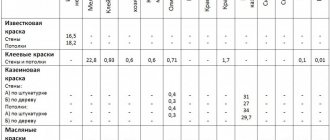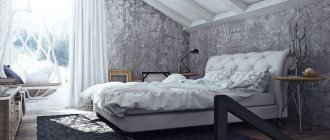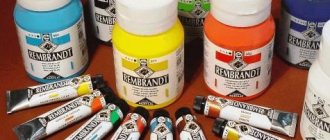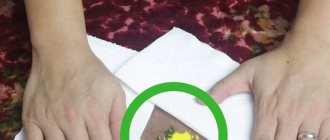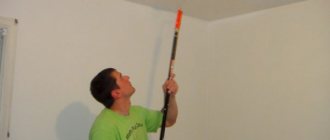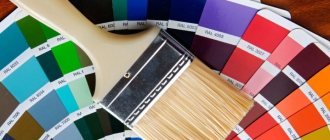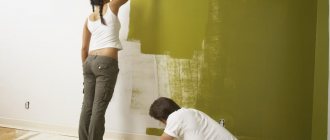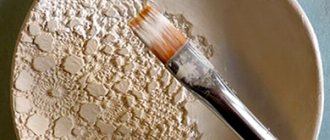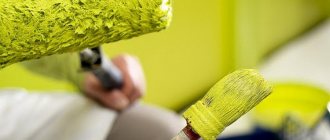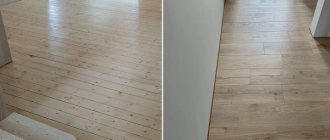Pigment dyes are added to the paint base, with an admixture of white and glue, which are diluted with water.
Gouache has a fairly dense texture. It is rich and quite durable.
It will be quite difficult to erase such material without additional devices.
Coloring agents give the surface a matte effect and velvety, and, as a rule, there are no problems with application. They lay down easily and in an even layer.
Surfaces painted with gouache can be corrected (it is enough to apply another layer of paintwork on top of the base).
The dye can also be combined with other materials, among which white is the most popular.
And if desired, colors can be combined to create new unusual tones.
As for PVA glue, it is one of the most popular and in demand on the market and is used in many areas.
It is ideally suited if it is necessary to carry out repair work and at the same time is often used for artistic purposes.
If this glue is mixed with gouache, you can get a number of advantages:
- High level of strength.
- Long service life.
- The surface will be embossed.
- Bases painted with this material can withstand volume well.
It is necessary to apply paintwork in thin layers and in several approaches (each previous layer must be thoroughly dry).
Otherwise, the layers will be too thick and will begin to crack and crumble.
If a pattern or painting becomes boring, you don’t have to throw it away. The material can be washed off quite easily, and the base, after drying, can be used for other purposes.
How to make water-based paint thick?
Take a bucket half full of water, add 1-1.5 kilograms of PVA glue there (it all depends on its consistency) if it ’s thick
, then 1 kilogram is enough. Next, 5 kilograms of sifted white or chalk and a little soap solution, about a glass or 50 grams of washing powder.
Interesting materials:
How to find out that a subscriber has deleted WhatsApp? How do you know if a person has deleted their Facebook account? How to find out that a person has deleted you from Viber? How do I know if I have been removed from my Skype contacts? How do I know that I have been removed from Viber? How do you know if you have been removed from your Skype contact list? How to find out what was deleted in Viber? How to find out which message was deleted on WhatsApp? How to find out who a person deleted on VK? How to remove blank lines after a table in Excel?
LiveInternetLiveInternet
Quote from Irozochka's message
Read in full In your quotation book or community!
Craquelure on PVA. Master class from Natasha Kosilka
I finally found the time to write to you about craquelure on PVA. I love making it and it always turns out much better than using single-phase craquelure varnishes. But the technology is the same. The first layer is acrylic paint. We don’t always get the craquelure mesh we need the first time, especially in the first stages of learning. You have to wash off the failed work. Therefore, I advise you, in order not to damage the acrylic paint applied to the surface, to fix it with a layer of acrylic varnish. Now I don’t do this, but at first it helped me. The second layer is PVA glue. I apply it with a brush in a fairly thick layer, spreading it evenly over the entire surface. Air bubbles may form on the surface, which is clearly visible in the picture. I remove them with my hand, gently rubbing them over the surface. These bubbles then don’t look very nice on the surface. I dry this layer, but not completely. It’s just that the glue should not stretch behind the brush and not stick to your hands, but under the top film it will still be damp. In some places it will become transparent, and in some places it will remain cloudy. This is clearly visible in the photo.
I’ll say right away that the glue should not be rare and not every glue produces craquelure. I experimented and made craquelure with two types of glue. The results and what kind of glue was used are clearly visible in the photographs.
The second glue is my favorite glue, which I use for craquelure. I advise you to find your own glue. Buy different brands of glue each time and try to make craquelure with them and you will find your glue. I was lucky, I found it the first time. The glue should not be rare. Before use, the glue must be stirred well. Or you can even drain the top layer of glue and try craquelure on the lower, thicker layer. The third layer is a layer of acrylic paint contrasting with the first layer. It can be applied with a brush or very well with a sponge. On this board it was applied with a sponge. This makes the surface more uniform. Then we immediately dry this layer with a hairdryer. As it dries, cracks form.
I also noticed that if you apply pure art acrylic, then cracks may not appear, but if you dilute it with acrylic construction paint, then they appear without problems. this happens because art acrylic forms a more elastic film, which does not crack after drying, which is what we need in this case, but stretches. I usually always use construction acrylic and tint it in the artistic color I need. After the paint has dried, you can use sandpaper to remove any surface roughness after applying the paint with a sponge. Wipe with a damp sponge to remove dust from cracks. Cover with one layer of acrylic varnish and you can begin decoupage. To decoupage this board I used 2 types of napkins. I tore out the motives. I glued them with diluted PVA glue.
Then, after drying, I covered the board with 1 layer of acrylic varnish. Using a sponge, I applied a light background to the surface so that the napkin motifs looked like a single pattern. Everything was done using acrylic paints. I applied 2 layers of acrylic varnish. I sanded all the imperfections. At the end there are several more layers of varnish with intermediate sanding after each layer has dried. Job is done. A closer view of the cracks on the board.
Why do I like to use PVA for craquelure? Because it is much easier to apply a second coat of paint here. It does not roll under the brush and sponge, which happens with special products when you don’t dry them enough. Cracks do not appear instantly, but after a few seconds, which is enough to evenly apply the second layer of paint. The cracks are very graceful. And glue is much cheaper than special varnishes. PVA is easy to buy, but craquelure varnishes are not available everywhere. I hope everything works out for you too.
https://my.mail.ru/mail/papaimama_k/
What materials to use after PVA primer
After applying a primer made from PVA glue, different types of finishing can be produced. A thin protective film seriously reduces paint consumption and makes it easier to apply. This primer is ideal for acrylic and latex paints, as well as alkyd enamels.
After priming the walls, you can paste them with wallpaper: paper, vinyl, non-woven, using any wallpaper glue. To increase the strength of the connection, PVA is also often added to the glue. The primer composition is suitable for ceilings that are planned to be finished with polystyrene foam tiles: the degree of adhesion will increase.
Recommendations
Mixing water-based paint is a fairly simple operation that can be performed even by an untrained person. To get a high-quality mixture, you should follow a few simple recommendations.
Observe proportions when mixing. It is advisable that the volume of added water does not exceed 10% of the total amount. 1 part should be occupied by the solvent, and 9 by the water-based paint itself.
The exact percentages are often indicated on the packaging. Do not exceed the manufacturer's recommendations; this may lead to the film losing its strength characteristics after hardening.
The water should not be dirty. Not every tap liquid can be used as a solution. Various chemical compounds can also affect the quality of dilution. Therefore, it is important to consider the manufacturer's recommendations.
The paint should be dissolved with water at room temperature. Do not use hot liquid as it may break the bonds between the dye and the base mixture. This will result in loss of durability and performance degradation.
If you don't have time, you can mix cold and hot liquid, bringing it to room temperature.
Diluting water-based paint is the ability to obtain a solution of the desired consistency. This approach will allow you to obtain not only a reliably protected, but also a beautiful surface, which is practical and has a long service life.
For information on what water-based paint is, see the following video.
Operating procedure
As an instruction on how to work with polyvinyl acetate paints (PVA), we will provide this video in which craftsmen paint walls with similar paint:
Now a short summary for printing. Firstly, we check and select the coloring composition for suitability for use in a given room or location. Secondly, we prepare the working area for painting: we remove dust and dirt, seal cracks and seams, wash the whitewashed surface; to save money, you can apply a primer first. Thirdly, we remove dried lumps, stir the polyvinyl acetate paint, dilute the water-based composition with water according to the instructions, depending on the application method (brush, roller or spray). The final step is to apply several layers.
Industrial PVA glue from the manufacturer at a reasonable price
It is thanks to the presence of an adhesive base (PVA) that water-based paint is distinguished by unique technical data. Good adhesion parameters will be ensured only by high-quality PVA dispersion, which is also widely used in the textile, glass, footwear, and printing industries.
There are different types of PVA glue:
- plasticized (more susceptible to external influences);
- unplasticized (resistant to mechanical and climatic attacks);
- low, medium and high viscosity.
Visually, PVA dispersion is a viscous liquid of yellowish or white color (the presence of a tint is the effect of the presence of a plasticizer), homogeneous, without lumps or other foreign fractions.
The frost resistance of unplasticized PVA glue is up to 4 freezing and thawing cycles. All technical characteristics of the glue are indicated in the product description, and therefore you can choose the most relevant PVA option for specific target tasks.
The offer to buy adhesive for water-based paints is relevant for manufacturers of non-toxic paints and varnishes, as well as specialists involved in repairs or interior design and making paint and varnish composites on their own.
The range of applications for glue is quite wide. Find out from our consultant:
- how to add PVA to water-based paint to obtain the consistency of the desired viscosity;
- under what conditions should PVA-based paint be stored?
- what composition of water-based emulsion is suitable for interior/facade work, etc.
Oil-adhesive PVA putty
The composition of this building material includes acrylates, drying oils, and plasticizers. The putty has high plasticity, ideal for plaster, wood, metal, and after hardening it is easy to sand. The material can be applied in several layers: it is not subject to cracking or shrinkage. The only downside is that the putty is unstable in a humid environment, so it is used only in dry rooms.
To improve the technical properties, PVA is introduced into the finished putty in an amount of 10% of its total mass. You can also make the composition yourself; difficulties will arise only with finding the necessary plasticizers. When purchasing, you need to make sure that the expiration date corresponds to the norm, otherwise the material may peel off after drying. The quality of PVA should also be given due attention: it is better to take specialized building compounds from a trusted manufacturer.
Source
Advantages and disadvantages
The characteristics of PVA may vary depending on the added mass of the polymer substance, but as a rule they all have the following positive aspects:
- Easy to apply and dilute with water to the desired consistency;
- No toxins or unpleasant odor;
- Fireproof;
- Resistant to humid environments (not all of them are water-based);
- Do not deteriorate under the sun, do not change color;
- High adhesion and good alkali resistance;
- Resistant to mold and mildew;
- Dries quickly.
The disadvantages of polyvinyl acetate paints are:
- Low temperatures (below +6 °C) have a detrimental effect on performance and the manufacturer does not recommend painting at such temperatures. In addition, at a temperature of 0 °C and below, the paint may completely freeze;
- For decorating interior rooms with a humid environment and exterior work, it is necessary to select a suitable paint with a verstate or acrylate component;
- As polyvinyl acetate water-based paints improve, their prices become more expensive due to new additives;
- When applied to wooden surfaces, it is necessary to carefully prepare the rough layer. Such paints have high surface tension, so wooden objects are first cleaned and sanded several times.
Ceiling treatment with polyvinyl acetate water-based paints
Dilution technology
Water-based paints interact well with water. Therefore, diluting such a composition is quite easy and quick. This process consists of several sequential steps:
- Initially, you should take the required amount of paint into one container, and pour clean water into the second.
- Then liquid is added to the mixture in small portions. It is important to constantly stir the solution, this promotes uniform distribution of all components.
- If you need to change the color, you can add a special color along with water. The shade is selected individually, it depends on the characteristics of the original solution. In a similar way, decorative sparkles can be introduced into the structure.
When mixing water and water-based emulsion, foam may form on the surface of the solution. It is advisable to use the liquid after it has settled and the mixture has become homogeneous.
